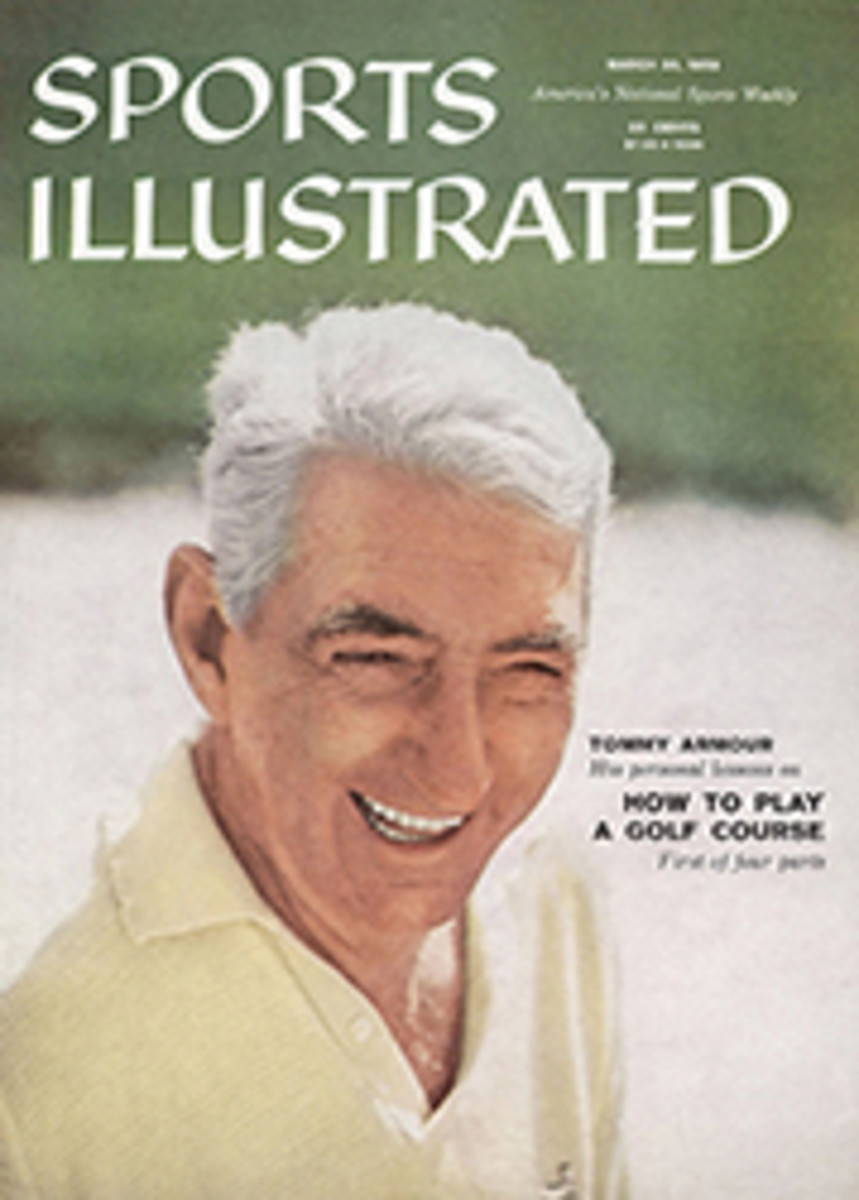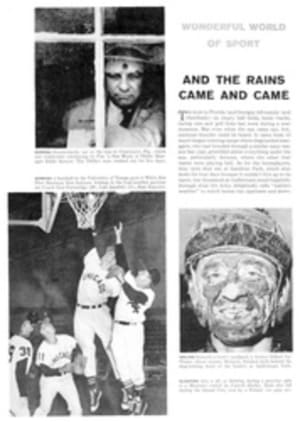
AN A FOR DARRALL
On a sunny August afternoon three summers ago, Pete Newell was sitting in his office on the University of California campus, about ready to yield to twin temptations of sunshine and a round of golf, when the phone rang, as is usual with the rise of the curtain on Act One.
A pleasant female voice said, "My nephew is coming up here to school in the fall from Los Angeles and I have to find him a place to live."
"They must have given you the wrong number," said Pete. "This is the athletic office. I'll have you switched to housing."
"No," the voice insisted, "they told me to speak to you."
"I'm afraid I can't help you," said Pete, beginning to wish he'd thought about that golf game a few minutes earlier. "I'm only the basketball coach."
"That's right," the aunt said with a note of satisfaction, "and my nephew is a basketball player."
Here we go again, Pete thought—everybody's nephew is a basketball player these days. But there was nothing to do but go through with it. "All right," he conceded, "what's the trouble about a place to live?"
"Well," said the voice, "the first thing is that my nephew has to have an extra long bed."
Suddenly the sunshine began to fade and golf was a game Pete could play any old time. "How tall is your nephew?" he said, and held his breath.
"Six feet eight," said the voice, "and he's still growing"—and as far as Pete was concerned it could be raining outside.
"What did you say this boy's name is?" said Pete.
"Imhoff," said his aunt. "Darrall Imhoff—with an A—and he's a very nice boy and he has fine marks in school and he wants to study forestry and he...."
"Don't go away," the usually polite Mr. Newell interrupted. "Stay by the phone. I'll call you right back."
Well, Pete found a bed and a place to live for Darrall (with an A, please) Imhoff. Actually, it wasn't much of a bed. As the handsome, blond crew-cut Imhoff tells it today, "What it was was an ordinary six-footer, and I put an orange crate on one end and put the pillow on that." And truth to tell, Imhoff wasn't much of a basketball player, either.
"I was just an awkward, growing kid," he says, "and the only reason I played at all in high school is because I was so big."
But Pete Newell made a basketball player of him, a darn good basketball player, and last weekend Imhoff repaid Pete for that and for the bed with the orange crate by twice coming through in the clutch and giving Newell and California the NCAA basketball championship. Playing against Cincinnati in the semifinal round, California was desperately trying to contain the great Oscar Robertson, with the score tied and about three and a half minutes to go. Robertson drove to the base line, close in to the basket, went up for his jump shot, and Imhoff blocked it. California took plenty of time setting up the subsequent critical play, and it was Imhoff who worked himself clear in a low post position, took the pass and threw in a left-handed hook to put his team ahead 56-54. There were two minutes to go. Seconds later, Robertson went in for almost the identical shot as before, and Imhoff blocked that one, too. California was ahead to stay and finally won 64-58. Imhoff was the leading scorer with 22 and his team's top rebounder.
The next night, with 52 seconds to go in the title game against West Virginia, California's lead had been shaved to one point. West Virginia was pressing magnificently, had stolen the ball repeatedly in the previous few minutes, and it was still anybody's game. Imhoff got the ball near the base line, a good 20 feet from the basket, and tried another hook. It was a bad shot; it rolled around the rim and came off. But Imhoff recovered beautifully, grabbed the rebound of his own shot and, off balance, he banked the ball perfectly off the board and through the cords.
There were 15 seconds left but the game was over. California conceded a shot and a basket to West Virginia, being careful not to foul, and won 71-70.
There was, of course, a great deal more to this final round in Louisville than Darrall Imhoff's two clutch performances. Sellout crowds of 18,000-plus saw some superb basketball both nights. But it is fair to say that the most important thing they saw was a demonstration of the principle often parroted by coaches and far too infrequently followed by many of them: that good defense wins ball games. Pete Newell showed them.
Pete is a slender, graying 44-year-old, perhaps best known to fans for his habit of chewing on a wet towel while he sits on the bench. ("I do it because my mouth gets so dry when I watch a game.") He has a flashing, quick smile, a vivacious blonde wife named Florence, four sons and the crusader's zeal for the kind of basketball he teaches—deliberate, highly disciplined offense and aggressive, man-to-man defense.
"People ask me," he says, "why I play what they call a slow style of basketball, the way they used to ask Eddie Lopat why he threw all that slow stuff and never a fast ball. And I give them the same answer he did. It's because that's what I do best and what our boys play best. Good defense doesn't take genius, it just takes hard work, and we work hard on it. I try to teach my boys to be aggressive, especially when they don't have the ball. When a player guards the man with the ball, the tendency is just to respond to his fakes and feints and try to stay with him. I try to teach my boys to take the initiative, to fake the man with the ball, to move him around instead of letting him move them around."
DO IT YOUR WAY
Based on this man-to-man principle, Pete's total team defense—and his offense, too—has the same purpose: to get the other fellow to play the way you want to play; the way you play best, not the way he plays best. It is a principle that applies to most two-man and team sports, from boxing to basketball. It sounds easy but it isn't easy to do, and it certainly wasn't easy to do against Cincinnati and West Virginia.
Cincinnati is a quick-breaking, rapid-fire shooting team with the third highest per game scoring average in the nation (84.0 points). And Oscar Robertson is tops, with 32.6 per game. The fact that California's defense held Cincinnati to 58 points and Robertson to 19 does not, actually, tell the real story. What is significant is that the defense allowed Cincinnati to get off only 56 shots, far below its normal average—not at all the kind of game it likes to play. For their part, the Californians, despite their deliberate offense, took 73 shots in the face of Cincinnati's less-efficient defense. That was the difference in the semifinal.
Robertson, it must be said, was not contained, and neither was his fine teammate Ralph Davis. Robertson repeatedly set up other Cincinnati players for easy shots, but as a team Cincinnati did not perform up to potential because California forced it to play ball the way California wanted to play.
The game with West Virginia was different in one important respect. The Mountaineers nearly matched the Bears with a superlative defensive exhibition of their own, especially a zone press that actually threw the Californians off stride for long periods. This press threw two men at the Californian who had the ball, naturally requiring a great deal of running around by the West Virginians as the ball was passed from player to player. It is a defensive tactic that involves great risk, because somewhere on the court there must be a free opposing player. The trick, for California, was to find him; for West Virginia, to get to him before he could shoot.
As this final game assumed shape, West Virginia, led by Jerry West's skillful feeding and accurate shooting, took a 10-point lead midway in the first half. True, the Bear's defense had slowed the Virginians' famed fast break to a walk, but it appeared that they could play California's slow game as well as their own fast one, and win at that, too. It is to the credit of Pete Newell's ability to instill discipline in his players that they did not panic at this extraordinary prospect. They stuck to their deliberate offense patterns, moving to options when the set plays were thwarted by West Virginia, and this tenacity first brought them even and, finally at halftime, to the lead, 39-33.
When play resumed the first break occurred. West Virginia came out obviously all fired up but, unfortunately, too much so. The Mountaineers were simply overeager, made a number of foolish errors, and California took advantage of every one of them to go ahead by as much as 13 points. West Virginia put on that zone press, steadied, and came back to within four points several times, but California simply refused to turn over the lead. It was 69-64 with two minutes left when Darrall Imhoff began his rise to the occasion. He blocked shots, deflected passes, got himself clear for passes when a teammate with the ball was in danger of being tied up by West Virginia's press. He was one important cog in a cohesive, disciplined unit.
And then, with seconds to go, Imhoff took his bad shot that turned out so well for him, for his team, for Pete Newell and for the principle of defensive basketball.
You might like to know that Darrall has grown to a well-muscled 6 feet 10 inches, and that he no longer has to pillow his head on an orange crate. He sleeps in a fraternity house now, in a bed that is 6 feet 6 inches long. He has to curl up a bit, but he likes it fine. And don't forget, it's Darrall with an A.
PHOTO
MARVIN E. NEWMAN
CALIFORNIA'S GIRL CHEERLEADERS GAILY WHOOP IT UP ALONG LOUISVILLE STREETS
PHOTO
MARVIN E. NEWMAN
COACH NEWELL CHEWS ON A WET TOWEL
PHOTO
MARVIN E. NEWMAN
ONLY 15 SECONDS TO GO, AND DARRALL IMHOFF (40) SAVES THE GAME AND BRINGS THE NATIONAL CHAMPIONSHIP TO CALIFORNIA
PHOTO
MARVIN E. NEWMAN
MRS. NEWELL LENDS HER VOCAL SUPPORT
PHOTO
MARVIN E. NEWMAN
UNIVERSITY'S STRAW-HAT BAND RAPTUROUSLY GREETS NEW NATIONAL CHAMPIONS

